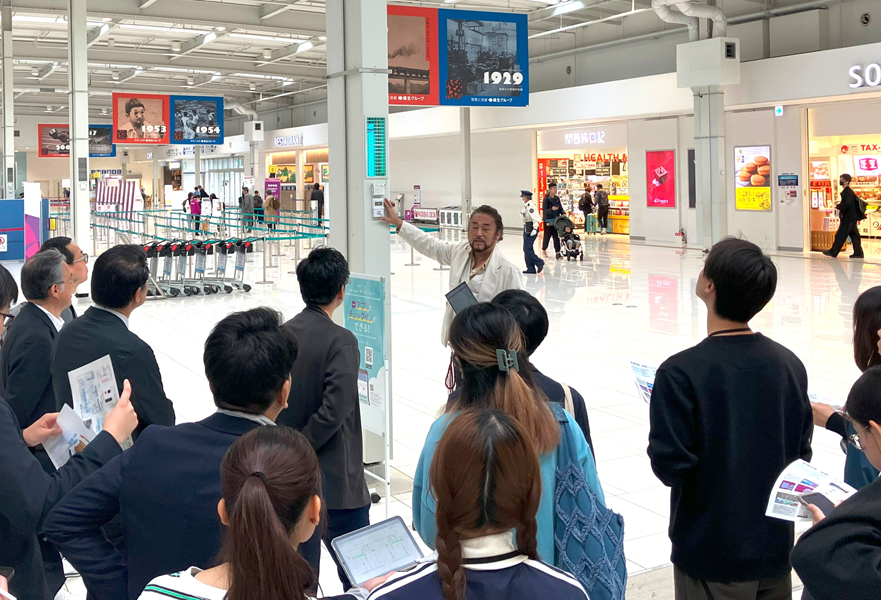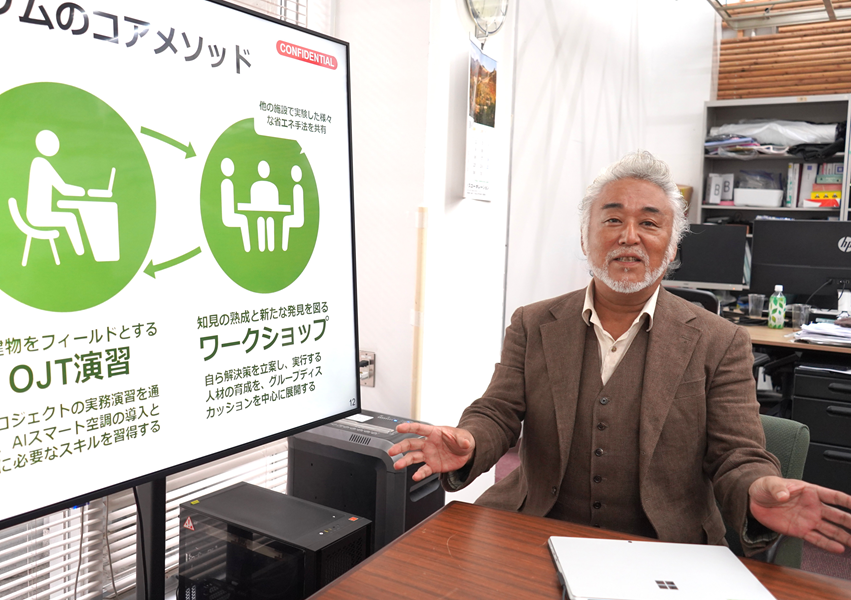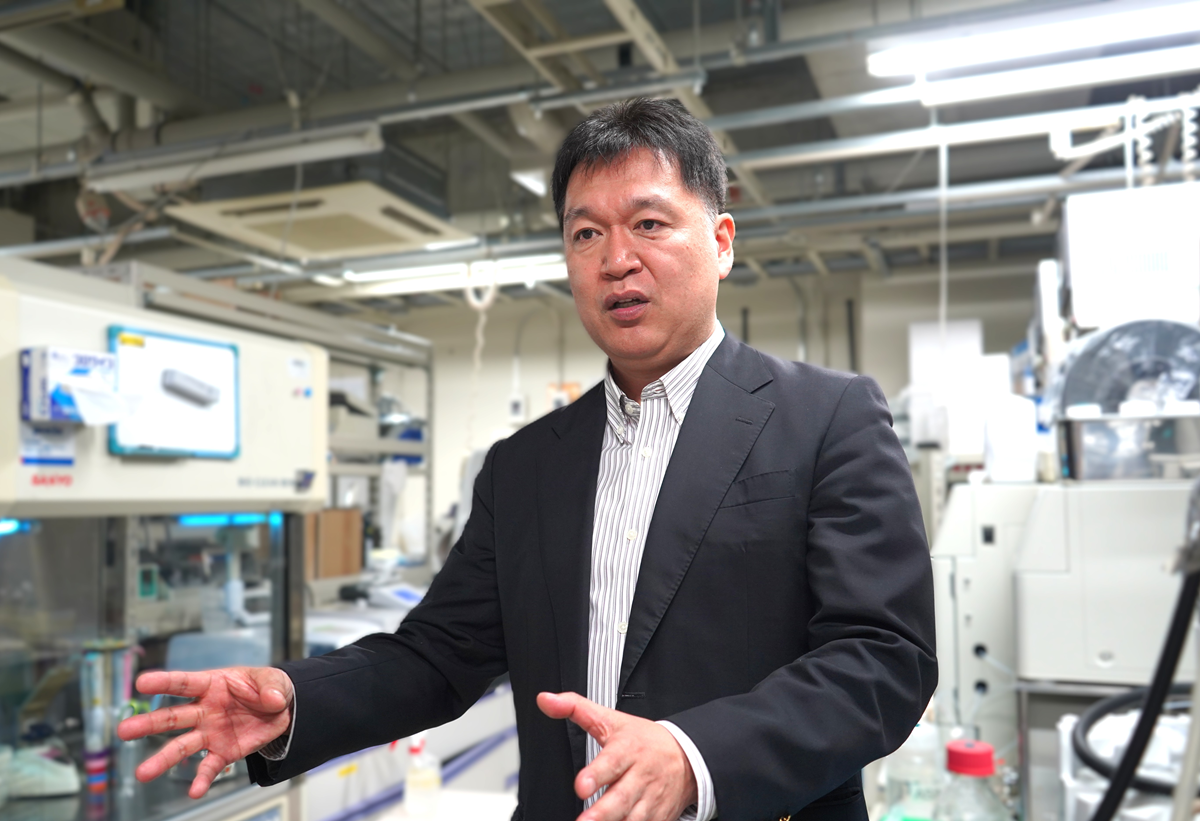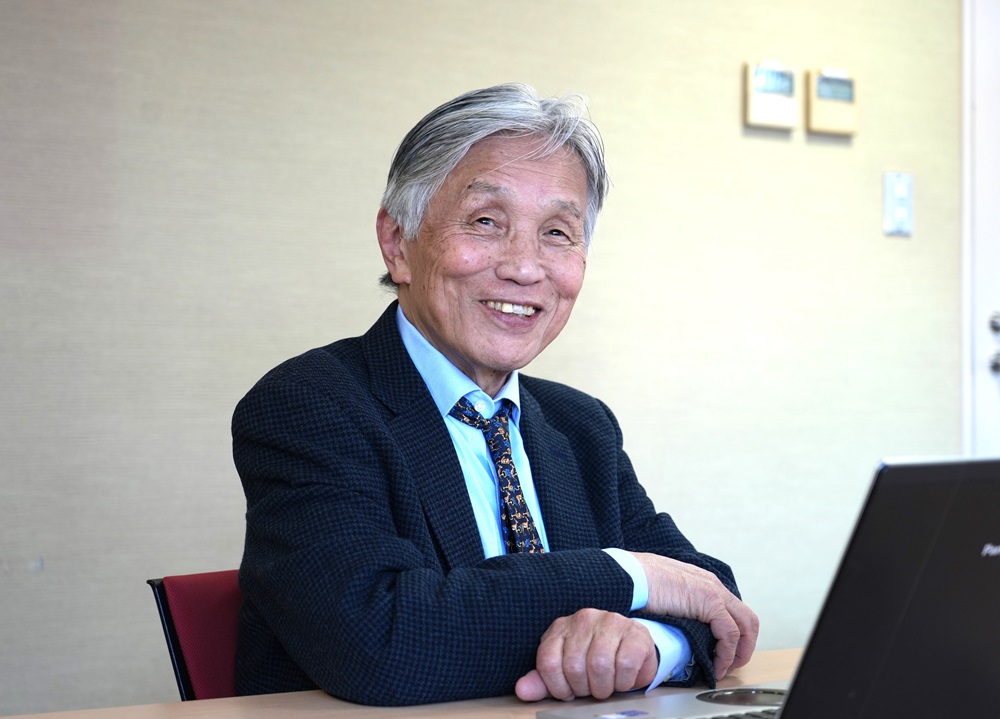
Empirical research is being carried out for revolutionary air conditioning technology that will contribute to solving environmental issues. At the forefront of these endeavors is NAGAHIRO Tsuyoshi, project professor and director of the Center for Smarttech System Co-creation in the Carbon Neutral Promotion Headquarters. Air conditioning systems enhanced by artificial intelligence (AI), or “AI smart air conditioning,” are being incorporated at facilities that use enormous amounts of energy for heating and cooling, such as airports and department stores, and have achieved significant energy saving results. We sat down with Nagahiro, who is engaged in everything from corporate collaborations to venture start-ups and practical education for promoting social implementation, to hear more about his current research and prospects for the future.
Predictive air conditioning based on the movement of people
What kind of technology is AI smart air conditioning?
Nagahiro:
One of the most significant characteristics of the AI smart air conditioning we’re researching is its ability to “see” the movement of people. Generally, conventional air conditioners set the temperature of a place the same whether there are people there or not without taking the movement of those people into account, which wastes a lot of energy. On the other hand, the system we’ve developed aims to measure the movement of people within a facility in order to make the places with people comfortable.
One other characteristic is how the system reuses air based on the temperature and distribution of humidity in an area. In any given area within a facility, there’s a temperature difference between the floor and ceiling. And at supermarkets, for instance, the air is colder in front of the frozen food section than anywhere else. Seasons and weather conditions can also cause temperature to change. These temperature differences are picked up by sensors, which then provide air conditioning by controlling which air to reuse and which to vent. We’ve already obtained a patent for this system.
Why did you begin this research?
Nagahiro:
It all began while I was working on thermal grid research during my time at Osaka City University (now Osaka Metropolitan University). There are national standards for the design of air conditioners used in buildings, but meeting those standards inevitably comes with excess, which led to me to think that I could make the equipment more efficient.
We first performed field trials at the international exhibition center INTEX Osaka in Osaka City. We constructed a piping system that connected the air conditioning of the six exhibition spaces to optimize air conditioning using technology that shared excess heat between the spaces.
Later, after moving to Kobe University in 2016, I developed this research into “AI smart air conditioning,” which incorporates AI and the Internet of Things (IoT), technology that connects things like appliances to the internet for applications such as data collection and remote control. This research made huge strides after a price drop of formerly very expensive sensors.
Installation and research at about 130 key locations
How did you go about performing field trials?
Nagahiro:
The first of our trials was at the underground shopping area “Santica” in Sannomiya, Kobe City. We went with Santica after a representative attended a symposium at the university on issues and needs regarding energy conservation. For a bit of context, I should also mention that representatives from Kobe City came to observe my work at INTEX Osaka while I was at my previous position.
At the time, it was said that conserving energy used by air conditioning for underground shopping areas would be difficult, as these shopping areas are connected with the outside, causing them to lose lots of air. Santica itself has 10 different exits and its upper portion forms a road above ground, making it easily affected by the outside air temperature.
Our field trials were carried out from 2017 to 2020 as part of a project by the Ministry of the Environment. After performing a thorough investigation of the movement of people and temperature distribution, we optimized air conditioning by predicting the movement of people and controlling ventilation accordingly. As a result, we were able to reduce energy consumption by over 40 percent.
In 2019, we were flooded with inquiries after this field trial was picked up by newspapers and made its rounds on internet news sites. We were also shocked to see how many corporate representatives and building owners attended the briefing session for the results of the trial.
At how many facilities are you currently working on projects?
Nagahiro:
We’re currently working at about 130 different locations. After our field trial at Santica, we started other experiments and joint research at various locations, such as subway stations, supermarkets, department stores and airports. Among these, we incorporated AI smart air conditioning technology during the construction phase of AEON Style Ebie, a supermarket opened in Osaka City in 2020. This was the first time we had implemented this technology in society, and we were able to reduce the power consumption of the facility by over 50% of standard consumption.
In 2021, we started Uni-TecH Co., a Kobe University startup involved with everything from installation of air conditioning systems to maintenance management, with install bases at department stores in the Kanto and Kansai areas. We also started another venture at Kobe University in 2023 called “H2O KU Carbon Neutral Design” based on a comprehensive collaboration agreement with H2O Retailing Corporation, operator of the Hankyu and Hanshin department stores. Through these business development efforts, we’ve made concrete advancements in energy saving and decarbonization at various facilities.
We’ve also installed a system in Terminal 2 at Kansai International Airport (KIX) and are preparing to do the same at Haneda Airport. Even though airports are huge buildings with high ceilings, the spaces close to the ceiling six meters off the ground were air conditioned in the exact same manner as the populated areas just two meters off the ground. We’re trying to use our technology to change that.

But airports are full of people wearing all kinds of different clothes coming to and from destinations all across Japan. User traffic flow also differs from the kind found in commercial facilities, requiring us to respond to factors such as flight information. The technology we’ve installed at waiting rooms in KIX makes use of visualized temperature differences via various display devices to provide what we call “gradation air conditioning,” which encourages users to naturally choose the most comfortable locations within the room. We’ve already obtained a patent for this technology as well. At KIX, we’ve also incorporated a system that aims to prevent the spread of infectious diseases.
In the future, I’d like to incorporate our technology primarily at facilities that the private sector would have difficulties handling on their own, like data centers, factories and outdoor domes. We’re also in talks with trading companies to take this technology overseas. I think there’s a strong need for this smart air conditioning technology abroad.
Rooting cutting-edge technology in society through practical education for professionals
In 2023, you started the Center for Smarttech System Co-creation in the Carbon Neutral Promotion Headquarters. What sort of developments can we expect in the future?
Nagahiro:
Our focus at the center is human resource education. If you’re trying to establish new technology in society, you’re going to need people to install it and to operate it. We kicked off our practical education for professionals on AI smart air conditioning technology in 2023, and we’ve had about 20 employees from various corporations participate as part of their work each year.

This reskilling education is conducted over the course of a three-year program. In the first year, participants learn how to perform field trials that involve manually imitating movements controlled by AI at the fundamental level. This content is primarily aimed at employees engaged in maintenance management and operation of buildings. Classes in year two have participants learn how to create master plans, with facility contractors generally advancing to this level. Third year classes have participants work on facilities outside of their own at the applied level, with general contractors and subcontractors advancing to this level.
University researchers and technicians who have gained significant experience in the construction industry serve as leaders in our program. We hope that these individuals can pass on their broad range of techniques and experience to the next generation through this program, even after they reach retirement age. Ideally, I’d like to create a system that allows for both learners and teachers alike to move freely between corporations and the university throughout their careers.
Human resource development and exchange is pivotal in rooting cutting-edge technology developed at the university in society to solve social issues. I hope this new system for educating professionals establishes itself as a new form of education at the university, going even beyond our program in AI smart air conditioning technology.
Resume
After working for a facility design firm and at Osaka City University (now Osaka Metropolitan University), in 2016, became special project researcher at the Center for Collaboration Research and Technology Development, Kobe University. In 2020, became special project researcher at the Enterprise Partnerships Division, and in 2021, project professor in the same division. In 2023, became director at the Center for Smarttech System Co-creation, Carbon Neutral Promotion Headquarters. Also serves as chair of the Sakishima-Asia Smart Community Alliance.







